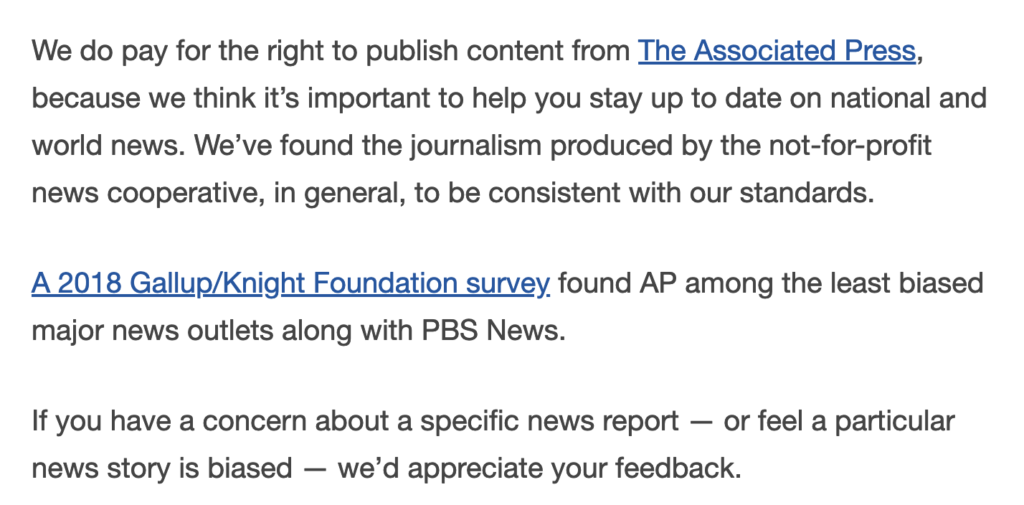|
Getting your Trinity Audio player ready...
|
“Wire-service and syndicated content can help to develop reading habits and retain subscribers among light and very light readers,” according to the latest research from Northwestern University’s The Medill Local News Initiative. “Even for the most ardent, heavier readers, wire content has a neutral – not negative – effect.”
Syndicated content is important to grow engagement. Any story’s a good story if you can get me to read it.
Edward Malthouse, Research Director, Northwestern’s Medill Spiegel Research Center
The finding which runs against conventional wisdom that places greater value on original news is based on an analysis of data from tens of millions of page views of two participating newspapers from Jan. 1, 2020, to Nov. 30, 2021.
“Magic for light readers”
The importance of this finding is underscored by the fact that another analysis from last year found that 49% of digital subscribers didn’t visit websites they had paid for even once every 30 days. “No one knows how long these disengaged readers will continue to pay for local news when they’re only rarely connecting with it,” writes Greg Burns, Editor, Medill Local News Initiative. News organizations need to reach these under-engaged subscribers before they cancel, adds Malthouse.
The Medill Subscriber Engagement Index data reveals wire-service stories’ effectiveness in retaining digital readers who rarely use their subscriptions. “It’s magic for light readers,” says Malthouse. “We’ve always felt the local news readers are concerned about the whole range of news … world, national, business, sports, entertainment,” notes Jim Kennedy, SVP, Strategy and Enterprise Development, Associated Press. “You’re forcing them to look elsewhere if you don’t run any of it.” AP has found that readers do leave local news sites in search of related content.
Keeping readers engaged is mission-critical for news organizations that count among their paying subscribers so-called “zombies” who use their subscriptions less than once a month.
Greg Burns, Editor, Medill Local News Initiative
“An opportunity to better tell your story”
However, running wire content comes with its own set of challenges. It can create trust issues. Many local publishers who rely on wire content to bring national stories to their readers have told Trusting News that their audiences are confused about who’s responsible for content from wire services or other partners.
They don’t understand why these publishers don’t cover national stories themselves. They don’t understand the processes and are unaware of resource limitations. Many readers also hold local publishers responsible for biased coverage when the content in question is actually syndicated.
“This isn’t necessarily surprising, right?,” says Mollie Muchna, Project Manager, Trusting News. “Wire content often covers challenging and politically divisive topics. Plus, research tells us trust is higher in local news outlets than in national news outlets, and often, wire services have different protocols and approaches to covering news than local news outlets.”
Joy Mayer, Director of Trusting News recommends publishers adopt a more considered approach towards syndicated content. They “need to spend more time discussing it or maybe put some additional guidelines in place,” she writes paraphrasing Trusting News partners’ observations.
If you publish a story — from your staff, from the Associated Press, from CNN, from The Washington Post, etc. — you’re responsible for it. Whether it’s an automatic feed on your website or a carefully selected story leading your newscast or front page, it’s part of the product you’re offering and you should be prepared to stand behind it.
Joy Mayer, Director, Trusting News
“When you find out people are curious about your process — or mad about something they don’t understand — it’s an opportunity to better tell your story,” adds Mayer. “Who else is going to clear up those misconceptions and fill those information gaps?”
“Help your audience better understand your process and goals”
Trusting News recommends publishers start by clearly labeling syndicated content to distinguish it from their own journalism. Headlines have been indicated as a frequent problem area.
“Some lack attribution and some lack specifics,” says Danny Vandegriff, Copy Editor, McClatchy. “More headlines appear to be looking for web traffic and include gotcha phrases.” Rewriting the headlines to ensure that the labeling, adjectives, and tone suitably reflect the story can make them appear fairer and less slanted.
Publishers should also consider explaining their story selection process to readers. Trusting News encourages newsrooms to publish and promote these explanations in visible places alongside wherever wire content runs.
Here are some ideas on how publishers can do it.

Publishers can refer to The Caller-Times’ page detailing how they use wire in a general Q&A about the newsroom. Additionally, here’s an example of how Enid News & Eagle, a Trusting News partner, responded to a readers’ criticism of its national political coverage with an editorial mentioning AP content.

The more you can be transparent and on the record about your wire coverage, the more you’ll be able to clear up misconceptions and help your audience better understand your process and goals. (i.e. build trust!).
Mollie Muchna, Project Manager, Trusting News



